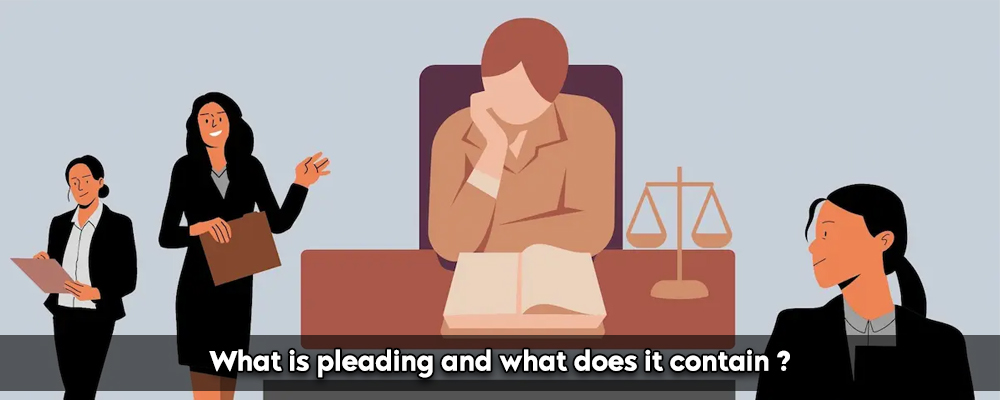The foundation of civil litigation is the legal process, and pleading is a crucial component of it. It entails the official presentation of each party’s legal arguments, claims, and defenses in a court case.
The legal procedure known as pleading allows parties to a lawsuit to legally disclose their views, accusations, and defenses. It starts the legal process and establishes the case’s foundation.
Need A Legal Advice
The internet is not a lawyer and neither are you. Talk to a real lawyer about your legal issue

Purpose of Pleading
- The claims or defenses being presented are made known to the opposing party in the pleadings. This notice is necessary to ensure that all parties are cognizant of the matters at issue and have time to appropriately prepare their cases.
- By describing the breadth and substance of the disagreement, the pleadings build the legal foundation for the case. They list the particular legal problems that must be remedied.
- Pleadings help define the boundaries of the lawsuit, preventing parties from introducing new claims or defenses that were not initially raised.
- By clearly articulating their claims and defenses in pleadings, parties help streamline the legal process. This clarity can facilitate settlement negotiations and expedite the resolution of the case.
Elements of Pleading
Pleading by Plaintiff
The complaint is the first document a plaintiff files to start a civil case. It includes the following elements-
- The caption at the start of the complaint lists the names of the parties to the litigation as well as the name of the court.
- This section describes the grounds upon which the court has jurisdiction over the subject matter (e.g., federal law) or personal jurisdiction (e.g., the defendant’s place of residence) over the case.
- The plaintiff and defendant(s) are named in the complaint, and often their addresses are included as well.
- In this section of the complaint, the plaintiff outlines the key facts that led to the case in a succinct and understandable manner. It contains both the legal claims being made and the alleged wrongs the offender is accused of committing.
- The complaint lists the causes of action or claims that the plaintiff has in court. Allegations of fact must be made in support of each claim in order to prove the defendant’s liability.
- In the prayer for remedy section of the complaint, the plaintiff asks the court for specific remedies or relief, such as monetary damages, an injunction against further action, or other types of legal recourse.
Pleading by Defendants
The defendant’s reply to the plaintiff’s claim is the solution. It responds to each of the accusations and arguments put out by the plaintiff. The crucial elements of a response include-
- The defendant is required to either admit or reject each charge contained in the complaint. Usually, if this isn’t done, the accusation is taken to be true.
- Constructive defenses, which are justifications for why the defendant shouldn’t be held accountable even if the plaintiff’s accusations are genuine, may be included in the response.
- In some circumstances, the defendant may make claims against the plaintiff; in effect, this is the same as launching a new lawsuit.
Response of Plaintiff to Counterclaims
The plaintiff may reply if the defendant includes counterclaims in the answer. The defendant’s counterclaims are addressed in this pleading, which may also raise defenses, additional claims, or both.
Modifying Pleadings
It is critical to remember that pleas are not binding. Normally, parties can ask to alter their pleadings to fix mistakes, include more claims or defenses, or seek other changes. However, modifications must often be made with the court’s approval or the opposition party’s assent and must not adversely affect the case or take undue time to complete.
Finding and Proof
The legal process continues on to discovery when the pleading stage is completed and the disputed issues have been established. Parties share pertinent information, paperwork, and proof during discovery. In order to bolster their claims or defenses, each side uses this phase to compile the information and proof they will need.
You will need the help of a Legal counsel to assist you in drafting and pleading. In the legal profession, drafting in law is the methodical and exact writing of pleadings, contracts, laws, and other legal documents in order to accurately and clearly express legal rights, responsibilities, and terms. By guaranteeing legal conformity, clarity, and accuracy in the contract’s formulation, lawyers play a crucial role in drafting contracts.
One can talk to a lawyer at Lead India for legal assistance. Free legal advice online can be obtainable at Lead India. Along with obtaining free legal advice online, one can also ask questions to the experts online free from Lead India.





 Talk to a Lawyer
Talk to a Lawyer